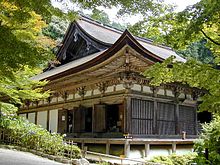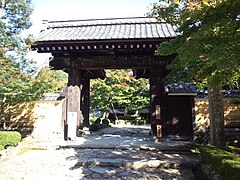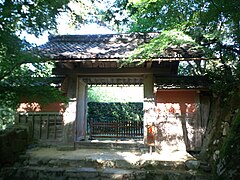Kongōrin-ji
The Kongōrin-ji ( Japanese 金剛 輪 寺 ) is a temple of the Tendai direction of Buddhism in Aishō in Shiga Prefecture , Japan . It is the middle of the "Three Temples in the West of Lake Biwa ".
history
According to temple tradition, priest Gyōki is said to have built the temple at the request of the emperor Shōmu . On the east side of the lake the Echihata ( 依 智 秦 ) were powerful from time immemorial , they are likely to be involved in the construction of the temple. In the Kashō period (848-851), priest Ennin ( 円 仁 ; 794-864) tried to revive the temple and led the temple to the Tendai school. At the end of the Heian period , when Minamoto no Yoshitsune was to drive out Yoshinaka ( 木 曽 義 仲 ; 1154–11484) on the orders of Yoritomo Kiso , he asked Buun Chōkyū ( 武 運 長久 ) to go to this temple and donate a large sword to him.
In the Middle Ages, the temple received support from the governors of the Ōmi province, the Sasaki belonging to the Ōmi-Genji, so that a number of hermitages could be built. But then the temple was affected by the Ōnin and Bummei turmoil , and finally Oda Nobunaga invaded the province and destroyed with the Sasaki Rokkaku ( 佐 々 木 六角 ), the last patrons. After all, the temple has the greatest treasures of the three "Three temples in the west of Lake Biwa".
The attachment
If you have passed the outer gate ( 総 門 Sōmon ) and climb the stone stairs, you will reach the main hermitage on the left, the Myōju-in ( 明 壽 院 ). If you pass its gate, the “White Gate”, you will reach the gardens of the temple from the Momoyama and Edo periods . The garden is designed to look at the water and the pond ( 池 泉 観 覚 式 Jizen kan'oku-shiki ), unlike the Japanese garden, not to enter. The garden on three sides of the monk's residence is registered as a natural landmark of Japan ( 国 名勝 Kuni meishō ).
To the right of the garden, on a higher point, is the Goma Hall (護 摩 堂) with a pyramid roof and the Suiunkaku tea house with a hipped roof ( 水 雲閣 ). In the Goma Hall there is a Daikoku-ten ( 大 黒 天 ), one of the Seven Gods of Luck , who is registered as an Important Cultural Property of Japan (hereinafter marked as ◎). Typical of very old representations, he shows an extraordinarily grim face and wears a half-robe.
If you continue up the stone stairs, you pass the Niten or Niō gate ( 二天 門 or 仁王 門 , ~ -mon ; ◎). It dates from the late Muromachi period and has a hipped foot roof covered with shingles made from cypress bark. Left and right watch two of the Four Kings of Heaven, namely Zōchō-ten ( 増 長 天 ) and right Jikoku-ten ( 持 国 天 ). Behind it is the main hall ( 本 堂 , Hondō ), also called the “Hall of Compassion” ( 大悲 閣 Daihi-kaku ). It is registered as a national treasure. It has a square plan of 7 by 7 Ken , which results in a side length of 21 m. The hall is in the "Japanese style" , mixed with a bit of Zen style , and has a hip roof covered with cypress shingles. It is divided into a front ( 外 陣 Gejin ), back ( 内 陣 Naijin ) and a back ( 裏 堂 Uradō ) devotional part. On the altar ( 須弥 壇 Shumidan ) there is a cabinet ( 厨子 Zushi ; ◎).
To the right of the main hall is a three-story pagoda ( 三重 塔 Sanjū-no-tō ; ◎), here called "Expect the Dragon Pagoda" ( 待 龍 塔 Jiryū-no-tō ). Originally built in the Momoyama period, it had deteriorated over time, so that only the lower floor remained. In 1978 it was taken apart and reassembled with the addition of missing parts. Now it is visible again in its old beauty.
Treasures of the temple
In the cabinet on the altar there is a standing Kannon as a cult figure. It is registered as an important cultural asset of the prefecture. To the right and left of the cabinet stand the heavenly gods or heavenly generals as if they wanted to protect Amida-Buddha . On the left there is a seated Amida Buddha ( 阿 弥陀 如 来 ; ◎) from the Heian period, on the right there is another Amida Buddha (◎). On both sides of it are the sky gods Fudō-myōō ( 不 動 明王 ; ◎) and Bishamon-ten ( 毘 沙門 天 ; ◎) from 1211, Jikoku-ten ( 持 国 天 ; ◎) and Komoku-ten ( 広 目 天 ; ◎), so two of the Four Heavenly Generals . - The altar is richly decorated with gold and mother-of-pearl and shows the Sasaki coat of arms, four squares with eyes arranged in a square ( 四 つ 目 結 , Yotsu meyui).
A small gilded Kannon figure made of copper was acquired by the American doctor and East Asia expert William Sturgis Bigelow (1850-1926). It is now in the Museum of Fine Arts, Boston .
photos
Remarks
- ↑ The other two temples are the Saimyō-ji ( 西明 寺 ) and the Hyakusai-ji ( 百 済 寺 ).
literature
- Shiga-ken rekishi sampo henshu iinkai (ed.): Kongōrin-ji . In: Shiga-ken no rekishi sampo (ge) . Yamakawa Shuppan, 2008, ISBN 978-4-634-24825-0 , pp. 50-52.
Web links
- Temple website (Japanese, English)
Coordinates: 35 ° 9 ′ 41.1 ″ N , 136 ° 16 ′ 57.5 ″ E






